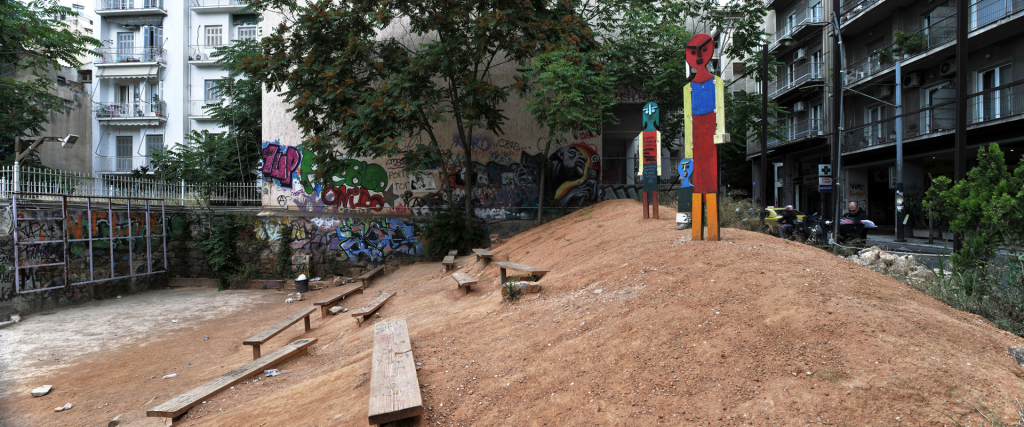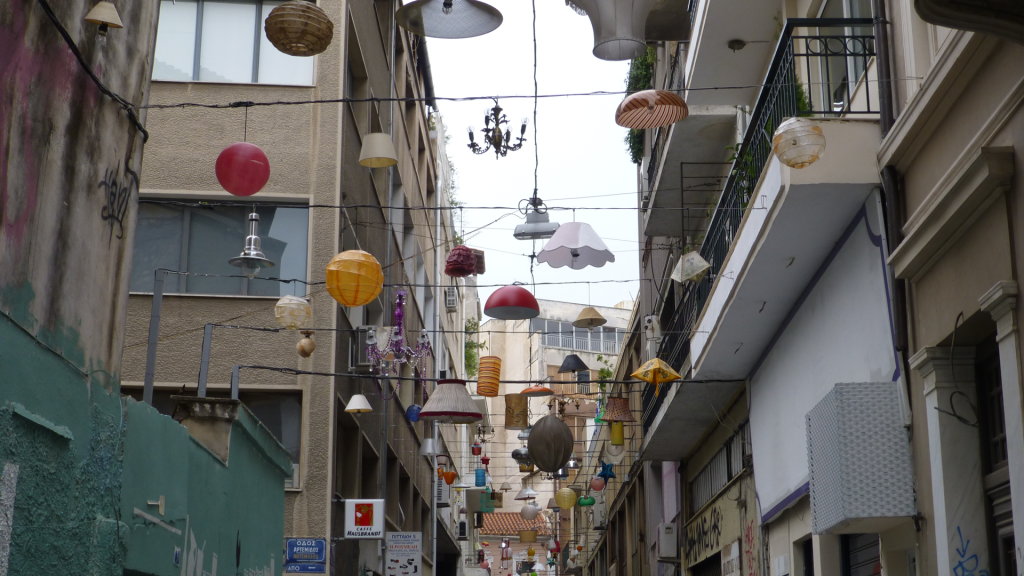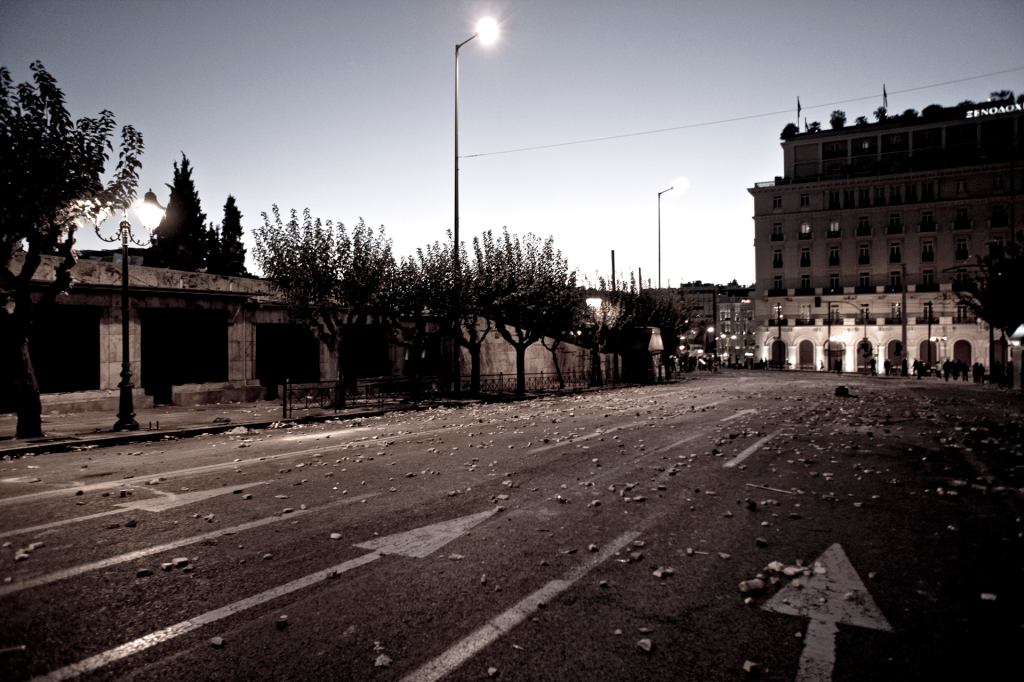Crushed Ground: The fragmented territory of austerity-stricken Athens
Essay by Panos Dragonas published in MONU 19 (2013), pp.88-93.
On the 8th of December 2008, the Christmas tree at Syntagma square caught fire during a street protest. During the same evening, a new upscale shopping center was launched at the northern suburbs of the city. Visitors crowded the new mall while the central square at Syntagma was full of young people protesting for the murder of a 16-year-old schoolboy by a policeman. That was a critical moment in the recent history of Athens. The center of the city was transformed into a surreal dystopia once the outskirts established themselves as a shopper’s paradise.
These two events were interrelated and complementary. The dominance of consumerist ideology reached its climax during winter 2008 – 2009, just before the outburst of economic crisis. The significant protests of December 2008 marked the end of a short period of prosperity and optimism for the centre of Athens that started during the years of Olympic preparation. December 2008 was also the moment of awakening for the younger Greek generation, an outburst of anger against the ideals of the previous decade and the lack of prospects for their future.
DIFFUSED ATHENS
The decentralization of Athens was a long-term political vision in response to the infrastructural problems of the city during post-war reconstruction. The concentration of public services in the center and the inadequacy of public transportation led to traffic congestion and created serious environmental concerns. The city has been constantly expanding since 19th century in response to the continuous growth of population. However, the diffusion of the city into the rural periphery reached its peak during the Olympic preparation. After the construction of major infrastructural works, such as the Athens Metro, the new International Airport and the new ring road of the greater Metropolitan area, the decentralization of the city would be finally achieved.
Since the 1990’s, traditional economic activities have slowly abandoned the historic centre of Athens. The last manufacturing activities either closed or left the area. Most high profile private companies moved along the avenues leading to the suburbs. Some public services, such as the Ministry of Education, moved into former Olympic facilities. Moreover, the construction of the new ring road encouraged the establishment of large shopping centers at the periphery, apparently against downtown commercial activities.
Suburban housing has been very popular in Athens since the formation of the upscale residential areas in the 1960’s. The economic growth of the early 2000’s gave the opportunity to the native middle-class population to pursue new lifestyles away from the historic center. Suburban residents sought substitutes for public spaces to the malls and multiplex cinemas that were created along the new infrastructure networks. The new commercial and leisure areas in proximity to the suburban areas formed the ideal environment for the middle class, in accordance with the consumerist ideals and standards of the lending-based economy in the 2000’s.

Fig. 1. New lifestyles. Photo by Nileta Kotsikou (imatiothiki.com).
INCOMPLETE URBAN RENEWAL
The diffusion of Athens into the periphery created a major gap in the traditional center. Decentralization created opportunities for the new city contenders, such as the immigrant population, the emerging creative class and the leisure industry.
During the greatest part of the 20th century, Athens was a city with homogenous population and very small religious minorities. The first groups of immigrants arrived in Greece from Eastern Europe after 1989. Their social integration was harmonious as long as the economy maintained positive growth rates and offered new jobs. During the late 1990’s, the first ethnic groups created their communities in the abandoned central districts forming new diverse neighborhoods.
They were soon followed by the leisure industry that has responded very quickly to any important change at the center of Athens. Graffiti artists and the gay community have been the best trackers of downtown areas with urban potential. Many districts, which were abandoned by manufacturing activities or services, were soon transformed into hip areas filled with nightclubs, cafes and tavernas. At the same time, the vibrancy of these multicultural areas with colorful markets and ethnic restaurants attracted the new creative class of the city, mostly young, well educated, people that have lived in western metropolises, who set up their workspaces, design studios and art galleries there. New loft like apartments were soon created in order to satisfy the demand for downtown living in the “Athenian SoHo”.
This is a well known gentrification process in the history of cities. However, in the case of Athens, it was never completed. Even in the days of artificial economic growth, the local economy was not strong enough to sustain the creation of new residential areas. Furthermore, the outburst of the debt crisis cancelled any plan of development in the centre of Athens.
During the period of the Olympic preparation, the state implemented the major project of the unification of the archaeological sites of Athens. Part of the broader plan was the regeneration of the central public spaces of the city after the construction of the new metro stations. The success of the pedestrian ring road around Acropolis was not repeated in the central areas of the city. Unfortunately after the first failed attempt, the state cut the funding of the broader regeneration project, and the urban renewal plan for the center of Athens remained incomplete.

Fig. 2. Graffiti at a former manufacturing area.
URBAN DECAY
The consequences of the financial crisis and the prolonged economic austerity measures are reflected at the centre of the Greek capital. The creative class, hardly hit by the economic crisis, has fled the area. The decentralization of the city during the Olympics was not followed by a plan for the redevelopment of the area. Inevitably the center of Athens was left in decline. Some of the most popular areas during the last decade show signs of urban decay. The empty shops at the commercial areas, the abandoned office buildings and the burned movie theaters give no hope for a quick recovery.
Homeless population increases so that it is very common to see people sleeping on the pavement. It is also common to see people collecting cans in shopping trolleys or well-dressed people begging for money. Poverty-stricken immigrants, refugees from Asia and Africa who are trapped in Greece in their effort to reach central Europe, inhabit the former multicultural neighborhoods. The current economic situation of the country can give no hope to these people. Furthermore, the appearance of Golden Dawn, a far extreme right wing, political party creates conditions of horror, which no one thought a European country might live again.

Fig. 3. Homeless in Athens. Photo by Mariana Bisti.
RECOVERY OF THE COMMONS
After the initial shock, local society soon tried to respond to the new urban circumstances. The mass protests of the Greek “indignados” at Syntagma Square in 2011 marked Athenians’ return in public space. New collectivities, grassroots movements and open communities, were soon formed in order to claim their right to the city in many different ways. It was also the first time since the Olympic preparation that new large scale regeneration plans were announced.
The state, lacking economic resources, depends on the support of public benefit foundations in order to implement top-down redevelopment programs. Stavros Niarchos Foundation finances the creation of the new National Cultural Center of Athens and the regeneration of Faliro Bay, both designed by Renzo Piano. While the Onassis foundation finances “Rethink Athens”, the ambitious program for the reconstruction of the city center, designed by OKRA after an international architecture competition.
On the other hand, public space is reclaimed through numerous bottom-up initiatives of the citizens. Among them, one may distinguish:
– The self managed Navarinou Park, a park that has been created, organized and maintained by the residents of the surrounding neighborhood, without the support of the municipality or state.
– The open community of “‘Atenistas” that has organized plenty of actions, such as the creation of small temporary parks, in order to give life back to the abandoned parts of the city.
– The group “Imagine the City” that organizes interventions in degraded urban areas and exhibitions of proposals to regenerate public space in different cities.

Fig. 4. Self-managed Navarinou park. Photo by Charalambos Louizidis & Aikaterini-Niki Glinou.
There are plenty of similar groups, communities and movements that are activated in Athens since 2008. These initiatives have much in common. They claim better living conditions in urban areas; they create new collectivities, and they rely on the voluntary work of their members. At the same time, there are serious ideological differences that separate these initiatives, regarding the way that they approach the space of the city. Some of the groups are offering volunteer work in order to support the public domain that is in decline. Whereas the collectivities, which were formed after the movement of December 2008, follow a more radical approach that is focused on the recovery of urban commons.
Since the outburst of economic crisis, there are many positive forces in Athens that follow different strategies in order to reclaim public space. However, at this moment, there are no signs of collaboration between these top-down and bottom-up initiatives. Moreover, the ideological differences among the active citizens, especially between liberals and leftists, as well as the pervasive distrust and suspiciousness do not encourage a sense of collegiality and collectivity that is essential in order to form a new “common ground”.

Fig. 5. Syn-Oikia Pittaki by “Imagine the City”. A lighting installation composed by lighting fixtures donated by the residents.
FRAGMENTATION
Since 2008, different groups of people and interests claim the public space of Athens:
– The impoverished immigrants, divided into ethnic groups, and the ever growing homeless population claim their right to the city in order to survive under harsh circumstances.
– The far extremist right wing creates an “ecology of fear” in order to increase its electoral influence in the conservative population.
– Open communities, collectivities and grassroots movements organize cultural activities and events in empty spaces and occupied buildings in a way that is not favored by the conservative government.
– Leisure industry grasps any opportunity to create new entertainment areas at any available area that has the potential to attract visitors.
– Real estate investors have returned in the centre of the city and are waiting carefully for their next step.
The actual condition of Athens does not reflect the real potential of a city built next to the Aegean Sea and around Acropolis. The centre of Athens is in decay not only because of the current economic and social crisis. The main reason of decline is the decentralization of the city during the Olympic preparation and the lack of a redevelopment plan afterwards. There is no doubt that in the future, when the country gets out of the turmoil of the debt crisis, the city will be very different. However, at the moment, the Athenian urban space is a fragmented territory. Crushed by economic austerity, various claims and contradictory pursuits, sometimes well-intentioned and sometimes not, the Athenian public space resembles quicksand that changes shape depending on the movements of the strongest contenders.
